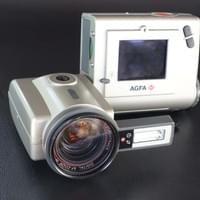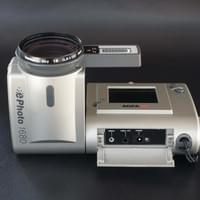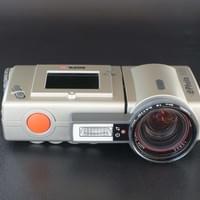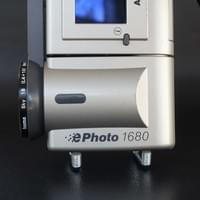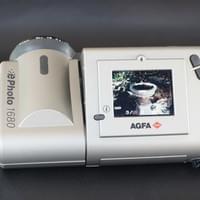
Agfa ePhoto 307 (1996)
Already by 1996, when the ePhoto 307 came out, some brands of cameras were beginning to take the shape of their 35mm predecessors. The difference was their cumbersome size.
This Agfa had useful features such as wide shutter range (up to 1/10,000 of a second), 2mb of internal memory and serial cable connectivity with a computer. Its tiny 0.35 megapixel resolution gave the game away, however.Agfa ePhoto 1680 (1998)
This is another of the early digital cameras which had no viewfinder. Instead, these cameras had an LCD screen for framing the photo. Nothing remarkable about that fact, but there was a problem if you held the camera anywhere but straight in front of your eyes. You could no longer see the screen.
A few manufacturers resolved this problem with cameras that could point their lenses in one direction and their LCD screens in another. Casio produced its QV line of cameras with swivelling lenses assemblies. Minolta went to the limit with its Dimage V. You could remove the lens entirely from the camera body and connect it via a cable.
Agfa was another manufacturer with the swivel lens solution which it employed in two of its ePhoto series cameras. The 1680 was the better of the two, having a 1.3mp sensor and a top resolution of 1600 x 1200 pixels.
As a photographer in 1998, you decide you like the swivel lens and you spend US$700 on the ePhoto 1680. But after you unbox and power it up, where are the controls? You've been distracted by the lens. You can only see an on/off knob, a shutter button and an optical zoom rocker. How do you adjust the shooting settings you've been reading about? Agfa has a secret. There is a small knurled wheel on the side called the EasyPilot button. You press this wheel and when you do, up pops a set of icons on the screen.
Now you have an embarrassment of adjustments such as external flash, white point, sef-timer, LCD brightness, digital zoom (1x or 2x), manual focus and flash including redeye.
Another secret . . . On the edge of the LCD screen there is a tiny rubber fitting that doesn’t look like a button, but it is. It’s the secret button that puts context-sensitive information on the screen.
Agfa seems to like secrets. Elsewhere on the camera there is a secret trapdoor that’s only revealed when you swivel the lens. It hides the SmartMedia card.
There you have it. A pretty camera with quality features of the era, and a lot of secrets.
David Leith © 2025







